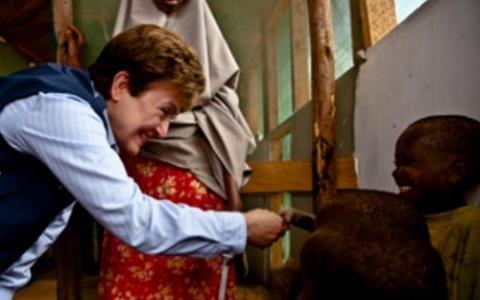 |
| EU Commissioner for Humanitarian Aid Kristalina Georgieva is pictured here at a visit in the Horn of Africa in end-July 2011. Photo from ec.europa.eu/commission |
EU Commissioner for Humanitarian Aid, Bulgarian Kristalina Georgieva, has confirmed on behalf of the European Commission the allocation of EUR 60 M in aid for tackling the impact of the drought in the Horn of Africa.
As famine has officially spread to a sixth region in Southern Somalia, the European Commission, the new humanitarian aid funding has brought the EC's total contribution to EUR 160 M.
"More than 13 million people are in urgent need of humanitarian assistance in the Horn of Africa. People need food, shelter, water and protection," said Kristalina Georgieva, European Commissioner for International Cooperation, Humanitarian Aid and Crisis Response.
"It is simply unacceptable that a child should die of starvation in the 21st century. This additional funding confirms that the people of Europe stand by the most vulnerable people in the Horn of Africa," she added, as cited by the EC press service Monday.
The European Union (EU) has mobilized more than EUR 700 M towards the droughtin 2011 alone. This amount includes nearly EUR 460 M in confirmed contributions from Member States, as well as the Commission's direct support.
Commissioner Georgieva, who recently participated in the International Pledging Conference organized by the African Union in Addis Ababa, emphasizes the need to coordinate the emergency response and to seek out sustainable solutions that link relief to long-term development.
The new money comes from the Commission's Emergency Aid Reserve and was approved by the European Parliament and the European Council. EUR 40 M have also been allocated to Sudan and South Sudan, the EC said.
This new funding will go towards boosting emergency response in Somalia,Ethiopia, Kenya and Djibouti. In Somalia, where famine has officially spread to six regions in the southern part of the country and where more than 750 000 people risk starvation in the coming months, the European Union is providing life saving humanitarian assistance worth EUR 62 M, and focusing primarily in the most affected regions of south central.
The Commission says that in Ethiopia, pasture conditions are worsening and there is indication that more children are being admitted in therapeutic feeding centres in the south and south-eastern parts of the country. European Union humanitarian assistance in Ethiopia amounts to EUR 46 M, the bulk of it going towards food and nutrition interventions. In the Dolo Ado refugee camps, near the border withSomalia, acute malnutrition rates of children are above 40%, three times the emergency threshold.
It is estimated that more than 3.7 million people are now food insecure in Kenya. EUhumanitarian assistance to Kenya is nearly EUR 44 M, delivering aid to more than 2 million people through 13 partner organizations. In total, 485,000 people are now in the Dadaab refugee camps, in northern Kenya. Vaccination rates among newly arrived refugee children are low, thus increasing the risk of disease outbreaks.
The EC reminds that the current drought in the Horn of Africa is a result of several consecutive years of failed rains and poor harvests. The drought threatens the lives of 13.3 million people and comes on top of many other challenges including, prolonged conflict, displacement of people, scarcity of resources, climate change, lack of infrastructure and market access, distortion of competition, weak governance, and high food and fuel prices.
This emergency is exacerbated by the rapid movement of people, fleeing conflict andfamine in the southern regions of Somalia. More than 800 000 Somalis are de facto refugees in the region, and 1.5 million people are displaced inside Somalia.
Humanitarian access in Somalia remains challenging, especially in areas controlled by Islamist militias. Nevertheless, the number of people in need of immediate humanitarian assistance in Somalia is estimated to be 4 million, practically half of the entire population.
Mortality rates among children under five who are internally displaced and temporarily settled in Mogadishu have reached a high of 15 per 10 000. The prevalence of acute malnutrition exceeds 30 percent in most areas of the south and is higher than 50 percent in the worse affected areas.
EU funding provides critically needed food aid, particularly to severely malnourished children, as well as health care, access to clean water, sanitation services and critical non food items, according to the EC.
Other priority actions include scaling up nutritional interventions for the most food insecure populations, providing agricultural support in at risk areas, continuing to provide minimum water requirements for human consumption, and protecting the livelihood assets of herders.

No comments:
Post a Comment